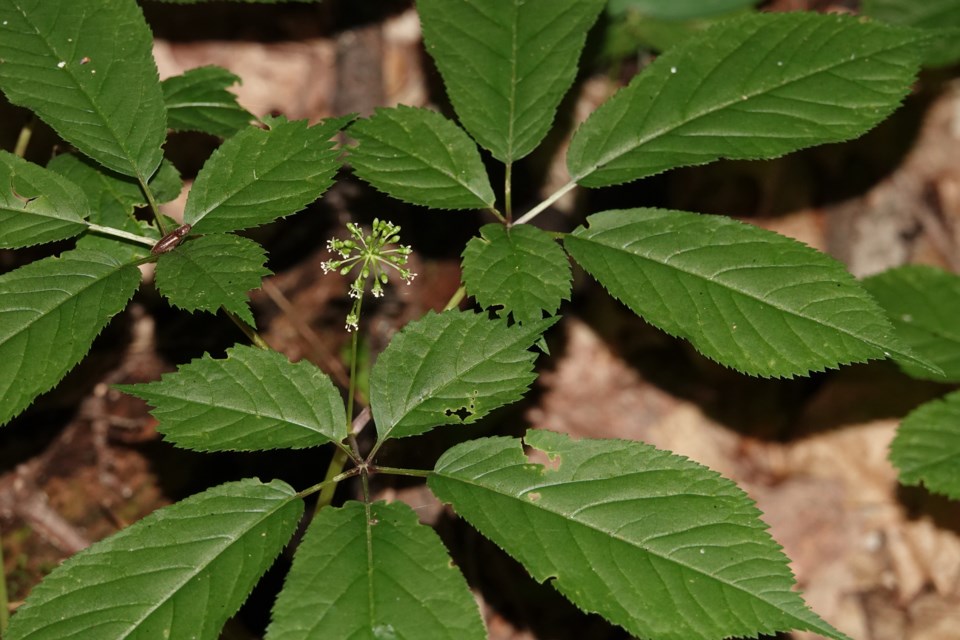Wild ginseng. Bet that got your attention. There is a strong allure about this woodland plant that most everyone falls for ... whether it’s the almost mythical healing properties it is supposed to have, or the romantic notion of traipsing through the woods harvesting nature’s bounty ... this plant does indeed grab your attention.
If you have an interest in field botany, you will know that wild ginseng is now a federally endangered species; should someone mention seeing it, you become intensely interested in that conversation.
Over the last couple of decades, I have had good fortune in locating several plants within the mature woodlands found across the northern parts of Simcoe County, and once in a limestone-based forest in Carden Township. However, each of these widely distributed stations contained only one to six plants.
For a station to ensure long-term existence of a plant, around 100 plants are needed. This allows for the usual natural loss of some seeds and enough survivors to keep the species entrenched and reproducing. And so the above experiences have me feeling doubtful about any long-term success of this very rare species.
The reasons for the crash in population of this once somewhat common plant are varied: habitat loss for sure; browsing by deer; collateral damage from wild turkeys raking leaves on the forest floor; harvesting and then over-harvesting and now foraging by people; the eating by birds and chipmunks of the few berries that are produced; plus a few hot years that have allowed plant fungi and bacteria to thrive. The odds for survival are not in their favour.
There is another reason that few reports come in about wild ginseng and that is, to the casual observer, there are a lot of other look-alike plants in the same woodlot.
Virginia creeper vine has the same five-leaflet radiating shape. Wild sarsaparilla (especially the first-year plants) look quite similar. And the flowers are not showy at all, just a tiny cluster of yellowish-green blossoms, easily overlooked even when the seeker is well versed in ginseng shape and form.
My hometown is Orillia, an area once upon a time a ‘never-ending flow of forested land’ where, apparently, wild ginseng grew in some profusion. The roots of wild ginseng were collected, used, traded and sold by the original peoples of the area. With the arrival of Europeans, this product became well known to them.
Where this story is going is that the scientific name for the Order of this plant is Araliaceae, based on the ancient Greek word “aralia”. After a couple of beers, it is obvious where Orillia got its name. Or so goes the legend.
Wild ginseng is well named as there is another ginseng, appropriately called Chinese ginseng, which is the type usually found in health food stores. Chinese ginseng is grown domestically and commercially, and despite being marketed as the cure-all for anything and everything, it is the root of the wild ginseng that purportedly has the greater healing powers.
The reason the wild roots have more ‘punch’ is that it takes seven to 10 years of growing in a hardwood forest before being ready for harvesting; Chinese ginseng is nurtured for three years in a planting bed. Having had the additional years to absorb all the minerals and elements found naturally in forest soil gives the wild ginseng a much better rep.
Dried wild ginseng root now sells for around $600 a pound. Which is bad news for ginseng plants, as new-age foragers are scouring the woodlots looking to either scoop some free roots, or make a wee profit on the black market.
But hold on a minute ... as wild ginseng is listed as both a federal and provincial endangered species, it is illegal to kill, collect or barter (in any way, shape or form) the root of a wild ginseng. And yes, some heavy fines have been imposed to the unlucky few who have been caught.
There once was a time in our great province of Ontario when the habitat of an endangered species was protected from being altered by development. Not so much anymore. By example, the recent clearcutting of shrubs and trees in the anticipation of widening the Horseshoe Valley Road has wiped out a small colony of wild ginseng.
As stated, I have had wonderful opportunities to explore many of the local woodlands, and yes, wild ginseng is still out there. Whenever I trip over a new plant (figuratively, of course) my pulse quickens a bit, as the discovery is unique and special. Knowing how scattered they are in their distribution, it is akin to winning a botanical lottery to find one.
On your summer rambles, keep both eyes open for the chance of finding this very special woodland wildflower. But do not post the location on any social media, as there are still those lurking around out there who seek the root for its magical, mystical and legendary powers.
With less than 100 wild plants remaining in north Simcoe County, let’s hope they can hang on for a few more years.
